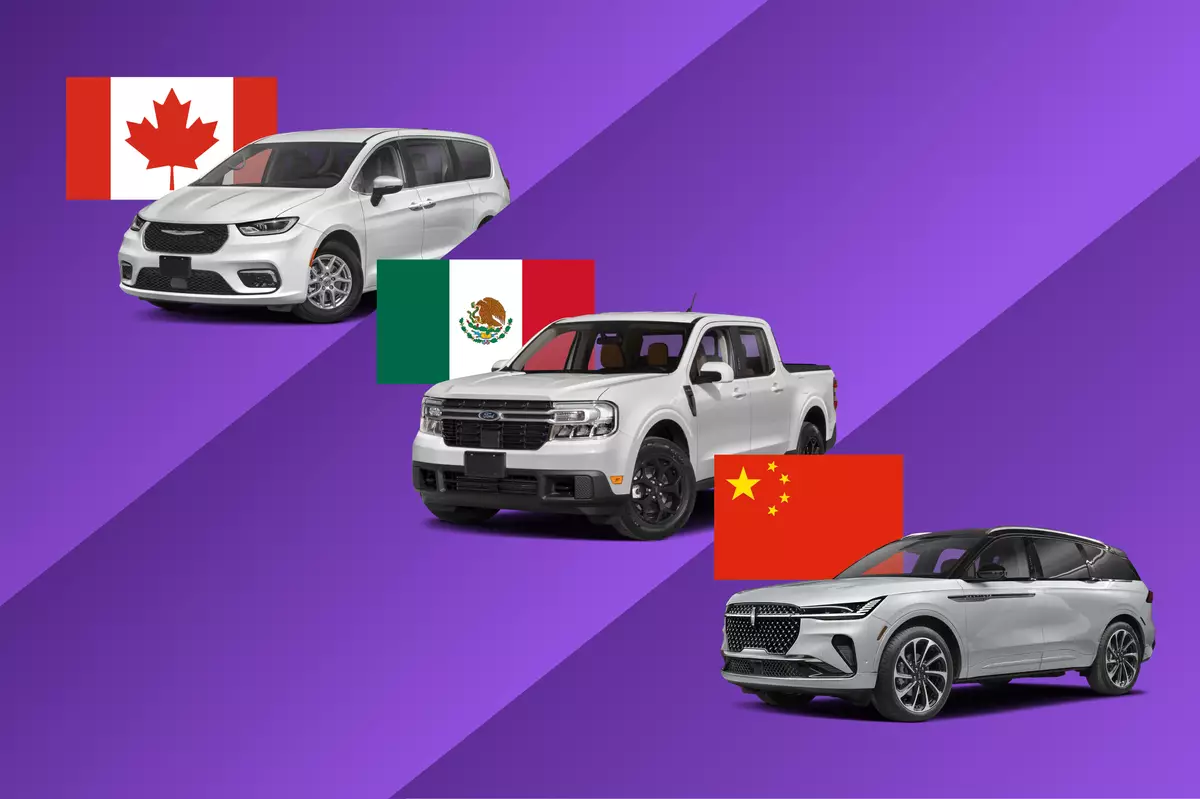Tariffs on Mexican, Canadian and Chinese Goods Could Affect These Cars the Most


Editor’s note: This article was updated March 27, 2025, to update the list of imported vehicles. The latest information on tariffs on all imported vehicles can be found here.
If you’re shopping for a new Ford Maverick or Chevrolet Equinox, you may want to consider buying sooner rather than later. These are just two of the many vehicles that could be affected by steep new tariffs on Canadian, Mexican and Chinese goods that President Donald Trump pledged to institute when he assumed office.
Related: Which Cars Are Made Outside the U.S.?
On March 26, Trump said a 25% tariff for all imported vehicles, including those from Mexico, Canada and China, would be implemented starting April 3. When implemented, the tariffs could result in higher prices for imported vehicles from the three countries.
Tariffs and You
Tariffs are applied to goods imported to the U.S.; the higher the tariff on an item, the more it costs companies and individuals to import that item here. Proponents of tariffs say they encourage companies to move more production to the U.S., while detractors claim the extra costs of importing goods or shifting supply chains often get passed on to consumers. To read more about how a tariff affects the pricing of a car, check out our primer on existing Chinese tariffs.
There are obstacles in the way, such as the fact that additional tariffs on Mexico and Canada appear to go against the terms of the U.S.-Mexico-Canada Agreement, a trade deal implemented during Trump’s first presidential term.
Which Cars Are Most Affected?
While tariffs on vehicles’ components could also increase the price of making new cars, fully assembled cars are among the most expensive goods that could be affected by Trump’s proposed tariffs. So, we’ve compiled a list below of U.S.-market models assembled in Canada, Mexico and China that are most at risk of a tariff-related shake-up, either in supply chains or pricing.
Which Cars Are Made in Canada?
- Ford Mustang GTD
- Honda Civic
- Honda CR-V
- Lexus NX 250/350 (also assembled in Japan)
- Lexus NX 350h (also assembled in Japan)
- Lexus RX 350 (also assembled in Japan)
- Lexus RX 350h/500h
Which Cars Are Made in Mexico?
- Acura ADX
- Audi Q5/Q5 Sportback/SQ5/SQ5 Sportback
- BMW M2
- BMW 2 Series
- BMW 3 Series
- Chevrolet Blazer
- Ford Bronco Sport
- Ford Maverick
- Ford Mustang Mach-E
- Honda HR-V
- Hyundai Tucson
- Infiniti QX50
- Infiniti QX55
- Kia K4
- Mazda CX-30
- Mazda3
- Mercedes-Benz GLB
- Nissan Kicks
- Nissan Sentra
- Nissan Versa
- Toyota Tacoma
- Volkswagen Jetta/Jetta GLI
- Volkswagen Taos
Which Cars Are Made in China?
- Lincoln Nautilus
- Polestar 2
- Polestar 3
- Volvo S90
- Volvo S90 Plug-in Hybrid
Notes on Data
Our source data came primarily from model-year 2025 vehicles reported for the American Automobile Labeling Act, which requires automakers to disclose the final assembly location of all light-duty passenger vehicles. This excludes heavy-duty trucks (those with a gross vehicle weight rating of over 10,000 pounds), low-production exotic cars and fleet vehicles. Our team attempted to fill in the gaps in information from other sources where possible.
Some vehicles are produced in multiple countries; they’re noted above. You can always check the window sticker of a car you’re interested in to know for sure where that particular vehicle was assembled.
Additionally, the data don’t account for new-for-2025 models or supply chains that are already shifting. Volvo, for example, was already in the process of moving its upcoming U.S.-market EX30 production to Belgium as additional tariffs on Chinese-made EVs were announced in the summer of 2024.
More From Cars.com:
- Thinking About Getting an EV Before the Tax Credit Changes?
- How New Chinese Tariffs Could Affect Your Next Car
- 2024 Cars.com American-Made Index: What About the Least American Cars?
- 2024 Cars.com American-Made Index: Which Cars Are the Most American?
- More News on the American-Made Index
Related Video:
Cars.com’s Editorial department is your source for automotive news and reviews. In line with Cars.com’s long-standing ethics policy, editors and reviewers don’t accept gifts or free trips from automakers. The Editorial department is independent of Cars.com’s advertising, sales and sponsored content departments.

News Editor Stef Schrader joined Cars.com in 2024 but began her career in automotive journalism in 2013. She currently has a Porsche 944 and Volkswagen 411 that are racecars and a Mitsubishi Lancer GTS that isn’t a racecar (but sometimes goes on track anyway). Ask her about Fisher-Price Puffalumps.
Featured stories



